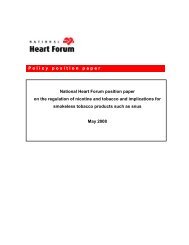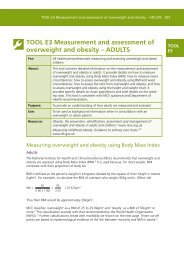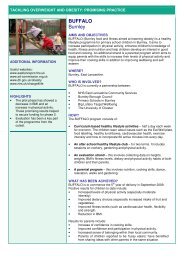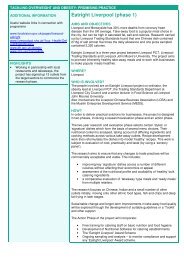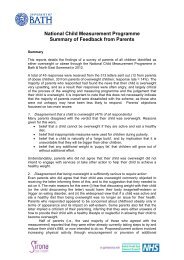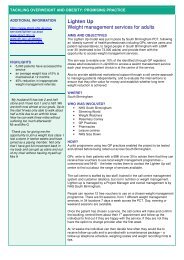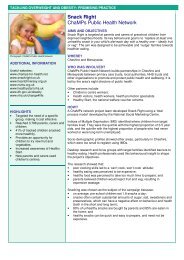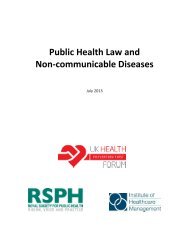The Challenge of Non-Communicable Diseases and Road Traffic ...
The Challenge of Non-Communicable Diseases and Road Traffic ...
The Challenge of Non-Communicable Diseases and Road Traffic ...
You also want an ePaper? Increase the reach of your titles
YUMPU automatically turns print PDFs into web optimized ePapers that Google loves.
4. THE RATIONALE FOR<br />
PUBLIC INTERVENTION<br />
This section describes the rationale for public intervention<br />
on NCDs <strong>and</strong> RTIs, under the following<br />
headings:<br />
• Economic rationale<br />
• Human capital rationale<br />
• Development rationale.<br />
4.1. Economic Rationale<br />
Experiences from different countries suggest that<br />
NCDs <strong>and</strong> RTIs may impose a huge financial <strong>and</strong><br />
social burden on government <strong>and</strong> society [156-157].<br />
As detailed in Box 2, recent assessment conducted<br />
in the Russian Federation <strong>and</strong> in China clearly illustrates<br />
the magnitude <strong>of</strong> this burden.<br />
Interventions for the prevention <strong>and</strong> control <strong>of</strong><br />
NCDs have been identified which are highly cost-effective<br />
[160]. Investment in their implementation is<br />
justified in economic terms in that the potential welfare<br />
gains <strong>and</strong> economic losses that could be averted<br />
are considerably larger than the investments themselves<br />
[161]. Justification can also rely on a rightsbased<br />
argument for NCD services: the raison d’etre<br />
<strong>of</strong> a health system is to address health conditions<br />
prevalent in the community, <strong>and</strong> health systems <strong>and</strong><br />
governments need to be responsive to the needs <strong>of</strong><br />
their citizens.<br />
While the largest share <strong>of</strong> costs <strong>of</strong> disease are borne<br />
by the individual concerned, the economic case for<br />
government action relates to ‘market failures’. <strong>The</strong>se<br />
are areas where the market alone fails to achieve socially<br />
optimal outcomes [162]; namely:<br />
• Externalities: <strong>The</strong>re are substantial external costs<br />
resulting from second-h<strong>and</strong> smoke <strong>and</strong> alcohol-induced<br />
RTIs <strong>and</strong> fatalities. NCDs also impose<br />
costs on health care <strong>and</strong> the social insurance<br />
system <strong>and</strong> hence on “third parties”.<br />
• Imperfect information: People are not always fully<br />
aware <strong>of</strong> the health (<strong>and</strong> other) consequences <strong>of</strong><br />
unhealthy lifestyle choices such as smoking, alcohol<br />
abuse, physical inactivity, <strong>and</strong> poor diet.<br />
<strong>The</strong>y may also be misled by deliberately distorted<br />
information promoted by the food, alcohol, <strong>and</strong><br />
tobacco industries. Government intervention in<br />
the form <strong>of</strong> the provision (<strong>and</strong> production) <strong>of</strong> NC-<br />
D-related health information (such as the health<br />
consequences <strong>of</strong> smoking) provides a public good<br />
that generally is undersupplied compared to the<br />
social optimum. This also includes the role for a<br />
government to engage in research about the health<br />
consequences <strong>of</strong> unhealthy behavior.<br />
• <strong>Non</strong>-rational behavior: Children <strong>and</strong> adolescents<br />
(<strong>and</strong> even adults) tend not to take into account<br />
the future consequences <strong>of</strong> their current choices,<br />
irrespective <strong>of</strong> whether they are informed about<br />
them or not. <strong>The</strong>ir current choices may well conflict<br />
with their long-term best interests. This provides,<br />
in principle, a justification for government<br />
to support interventions to prevent people from<br />
harming themselves in situations where they do<br />
not fully appreciate the consequences <strong>of</strong> behaviors<br />
that pose health risks.<br />
<strong>The</strong>re are two distinct rationales for public policy<br />
intervention to achieve a net improvement in social<br />
welfare, one equity-based <strong>and</strong> one efficiency-based<br />
[163]. Regarding NCD prevention <strong>and</strong> treatment in<br />
low- <strong>and</strong> middle-income countries, these could be<br />
framed as follows [160]:<br />
• For primary prevention, which is mainly through<br />
population-level <strong>and</strong> non-clinical interventions, a<br />
regulatory <strong>and</strong> fiscal framework is needed to limit<br />
externalities relating to tobacco (such as harm<br />
<strong>and</strong> associated costs resulting from second-h<strong>and</strong><br />
smoke) <strong>and</strong> alcohol (such as social harm <strong>and</strong> RTIs<br />
<strong>and</strong> deaths). Information can be provided in culturally<br />
appropriate formats about the various risk<br />
31



